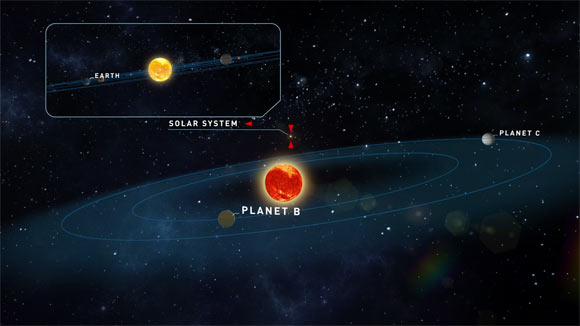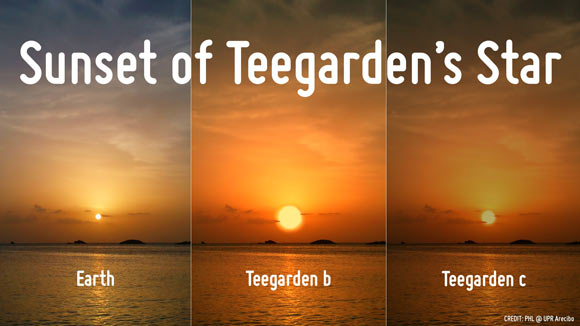Astronomers using the CARMENES (Calar Alto high-Resolution search for M dwarfs with Exoearths with Near-infrared and optical Échelle Spectrographs) instrument at Calar Alto Observatory have found clear evidence of two potentially habitable exoplanets orbiting Teegarden’s Star, the brightest and one of the nearest ultracool dwarf stars in the solar neighbourhood.

An artist’s impression of two planets orbiting Teegarden’s Star. Image credit: Institute for Astrophysics, University of Göttingen.
Teegarden’s Star is located in the constellation Aries, about 12.5 light-years away, making it the 24th nearest star to the Sun.
Also known as GAT 1370 and SO 025300.5+165258, this star was discovered in 2003 by NASA astronomer Bonnard Teegarden and colleagues.
It has a mass of around 8% that of the Sun, a radius 10% solar, and a temperature of about 4,800 degrees Fahrenheit (2,630 degrees Celsius). For its spectral type of M7 V, it shows relatively little activity.
“We observed Teegarden’s Star for three years, looking for periodic variations in its velocity,” said Göttingen University astronomer Mathias Zechmeister.
“The data clearly show the existence of two planets. They resemble the inner planets of our Solar System, are only slightly heavier than Earth and are located in the so-called habitable zone.”
Nabmed Teegarden’s Star b and c, the new planets have minimum masses of 1.05 and 1.1 Earth masses, respectively, and are among the lowest-mass planets discovered so far.
Both planets orbit inside their star’s habitable zone, where liquid water is possible, although one of the planets would need to have a rather special atmosphere in order to allow for water on its surface. Their orbital periods are 4.9 and 11.4 days, respectively.
Estimates put the system’s age at around 8 billion years, nearly twice as old as our own planet.

The apparent size of Teegarden’s Star from the exoplanets compared with sunset on Earth. Image credit: A. Mendez, Planetary Habitability Laboratory, University of Puerto Rico at Arecibo.
“Incidentally, within a few decades, it would be easier for hypothetical intelligent beings on one of those planets to detect Earth than the other way around,” the astronomers said.
“Between the years 2044 and 2496, Teegarden’s star will be positioned to see the Solar System edge on, and its inhabitants should be able to detect Earth using the so-called transit method as they see our planet pass directly in front of the disk of the Sun.”
A paper reporting this discovery is published in the journal Astronomy & Astrophysics (arXiv.org preprint).
_____
M. Zechmeister et al. The CARMENES search for exoplanets around M dwarfs. Two temperate Earth-mass planet candidates around Teegarden’s Star. A&A, in press; doi: 10.1051/0004-6361/201935460







